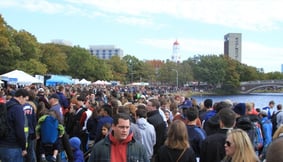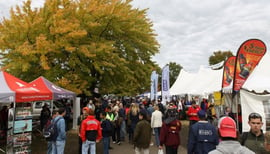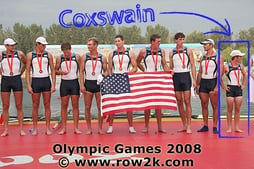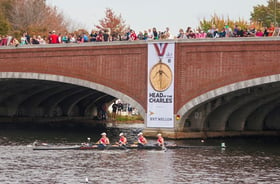
History of the Charles
The Northeastern United States is where many rowers flock to train because of the concentration of high quality teams, coaches and regattas. Specifically, Boston, Massachusetts is the rowing mecca and it is all because of the history of the Charles River.
There are 12 boathouses housing 17 teams for high schools, colleges and club teams with at least 50 or more people on each team and that is not counting the hundreds of independent rowers that house their boats in these boathouses. That might seem like a large amount, but there are hundreds more people waiting for their chance to get a boat on the racks in any of these boathouses.
In 1965, The Head of the Charles was founded and since then has grown into a world renowned, two-day regatta. There are around 11,000 athletes that participate from all over the world and more than 400,000 spectators that attend this amazing race. As a rower myself, I have raced in this regatta 3 times in my collegiate career and I must say, there is nothing like it. Since there are only so many boats allowed to enter each race and with the lottery bids open to any boat there is a chance that many teams will unfortunately miss the chance to race which, makes racing in it so remarkable.
A Rower’s Christmas
To all in the rowing community it is known as the “Rower’s Christmas”. Not because there is a lot of free little gifts, which there are, but because there are numerous tents with merchandise from many rowing specific companies, which is something of a rarity and why these two days are so highly coveted. Seeing new rowing technology, gear and companies is always exciting especially when you get to test out all of the demos displayed.

Toward the end of the race course near Weld Exhibition the spectator scene becomes more intense where tents from food companies are giving away free food and fun knick-knacks. This section is for everyone, spectators and rowers alike. If you are a spectator you better get over there before the rowers finish their races because there might not be any food left for you. This is also one of the most exciting viewing areas on the course for many spectators as they have a much higher likelihood of seeing a crash or two on the race course.

Closer to the Finish Line there are more merchandise areas including Expo and Hospitality Row with many more tents and fun challenges. This area also hosts many of the U.S. National Team as they have a tent where you can talk to them and get your gear signed by your favorite rowers. This area is also a great spot to view the crashes that Eliot Bridge produces, and believe me there are many. You can take a look here at some of the crashes in Head of the Charles past.
Preparing for the Race
As much as getting into the regatta can be a task, preparing for the regatta is a whole other beast. There is the physical training of getting ready for any regatta which every rower endures, but this race calls for more than that.

While it is important to have the fastest crew in the boat it is also detrimental for that boat to have the sharpest turns and most direct lines which means cutting valuable seconds off your time. In singles, doubles and quads that means having the most capable bow and in eights and fours that means having the best coxswain.
While there are coxswains and competitors meetings that go through the course map there is nothing like going on the course yourself. The days leading up to the race there is a large increase in boats on the Charles and strict rules are put in place.
This is the time for competitors who do not regularly row on the Charles to go through the course and find their lines for the race. At this time coaches’ launches are no longer allowed to be on the river, so it is only the crews and coxswains going through the course together and making a race plan for the big day. Once the prep is complete it is on to competition day.

The Race
We get to Riverside Boathouse two hours early so that we can lock our bikes up and go upstairs to the ergs for warm up. There are eight of us rowing this boat and we start off syncing together on the ergs. The pump-up music is on and we are all getting into our racing mindset. Since the warm up area on the water is a large one-way square we try not to launch too early from the docks.
There are a lot of pictures taken as we shove off to solidify the memories. Our teammates, parents and other club members are there watching the races before us and cheer us on to the start line. The whole boat is focusing in on the tempo and power 10s circling around the warm up area. The start time approaches, and we go to the mouth of the shoot.
The announcers call the start of the race and the boats start to build up through the shoot. Each boat is addressed individually, told to build and then, that’s it, “You’re on!” you hear from the Officials on the B.U. docks. The race has begun. My legs quickly start to burn as we do a power 20 to start the race off and settle into our race pace.
 We power through the B.U. Bridge, around Magazine Beach and past Riverside hearing our friends cheering. Then it’s the Power House stretch, the only straight-a-way on the course, were we do another power 20 through the bridges. We approach Weeks turn where it is all up to the coxswain to get the best line going into the JFK Bridge. We then pass the red door signifying 1 mile left in the race.
We power through the B.U. Bridge, around Magazine Beach and past Riverside hearing our friends cheering. Then it’s the Power House stretch, the only straight-a-way on the course, were we do another power 20 through the bridges. We approach Weeks turn where it is all up to the coxswain to get the best line going into the JFK Bridge. We then pass the red door signifying 1 mile left in the race.
The last bridge of the race is Eliot and is the trickiest to go through because of the short amount of time the coxswain has to line up the boat for the best line on the last turn headed towards the finish line. Our coxswain kills the turn and has us come perfectly into the final 500 meters of the race. We bring up the stroke rate to a 36 and cross the line. There will never be anything like racing in Head of the Charles.
References:
http://scullingfool.smugmug.com/Rowing
https://en.wikipedia.org/wiki/List_of_Charles_River_boathouses

